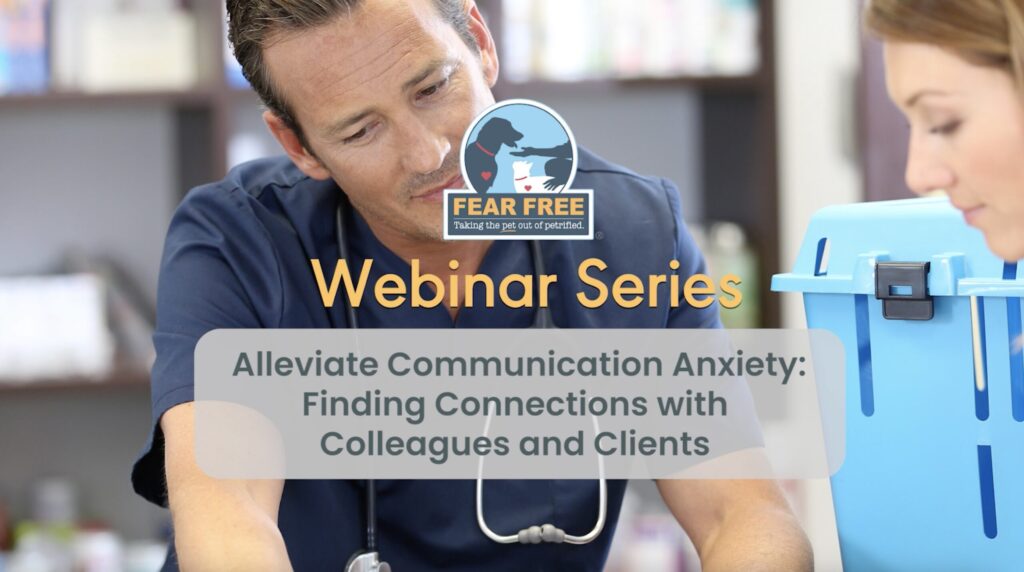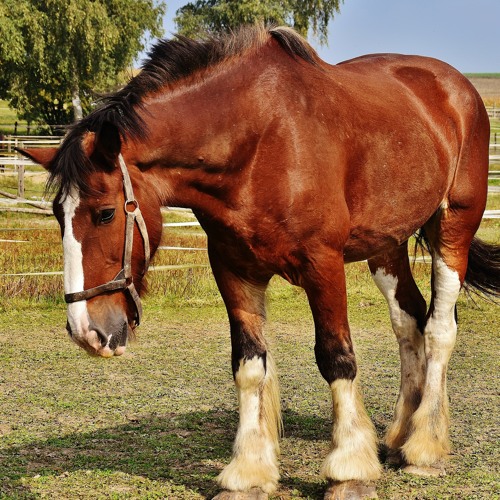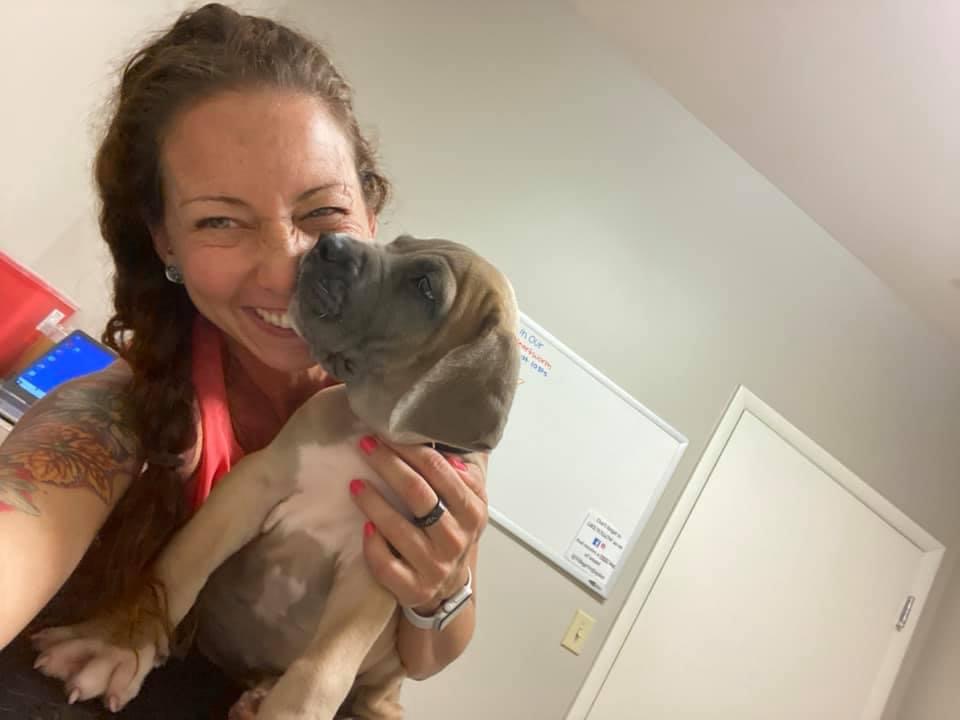
Understanding how our pets sense the world allows us to proactively address external stimuli to promote a more positive experience.

Understanding how our pets sense the world allows us to proactively address external stimuli to promote a more positive experience.

Showcase Your Practice: How to market your Fear Free Certified Practice
Has your team recently achieved the Fear Free Practice Certification? Congratulations! You’ve worked hard to implement the Fear Free standards through culture change, facility modifications, patient and client care, and more! Now what? How do you get the word out to maximize your return on investment? This webinar is for any Fear Free Certified Practice members that are looking for ideas on how to market your achievement. Natalie Gruchow, CVPM, Elite FFCP, was a practice manager for nine years and led her team to become the first Fear Free Certified Practice in the Dakotas. In this webinar, you will learn: Marketing strategies for your Fear Free Certified Practice How to ensure consistent messaging throughout your hospital with mindful brand cohesion Real world examples from the first Fear Free Certified Practice in the Dakotas How to locate community resources to market your brand Communication tips to overcome resistance and adversity
You must be a Fear Free Certified Practice member and logged in to view this webinar.

Alleviate Communication Anxiety
Finding Connections with Colleagues and Clients Communicating effectively with others is often challenging and stress-inducing. During this webinar, Dr. Maryse Osborn-Doser, DVM, Insights Discovery Client Practitioner with IDEXX, will walk through the value of a deeper understanding of psychology preferences in communications, along with tools to adapt and connect more effectively in conversations with your colleagues and clients. In this webinar, we will: Discuss how perceptions and preferences influence attitudes and decisions Describe the value of recognizing and adapting to personality preferences in communications Identify your psychology of preferences Evaluate how color preferences look in real life
Brought to you by our friends at Idexx.

When Cookies Can’t Compete: Fear Free Solutions for Non-Food Motivated Pets
Not all pets find treats irresistible, and for pet owners and pet professionals, this can pose unique challenges. Many pet professionals automatically reach for a tasty treat when rewarding, building a bond with, or reassuring the pet they’re working with, but what do we do when treats fail? Join us as we delve into innovative and Fear Free solutions for working with animals that may not be food-motivated. In this webinar, you will learn: – Effective, positive reinforcement methods that prioritize the emotional well-being of animals, fostering trust and cooperation – Methods to identify alternative motivators when traditional treats fail – How to tailor your approach to suit the unique personalities and preferences of non-food-motivated pets.

Our friends at Latah Creek Animal Hospital displaying their certifications at their clinic.
So, you’ve completed your Fear Free® Certification or Fear Free®Veterinary Practice Certification. First and foremost, congratulations, and thank you! You have taken a huge step in alleviating fear, anxiety, and stress for your clients, their pets, and even your team. Now it’s time to start spreading the word!
As you move through your Fear Free marketing journey, keep in mind that like all of us, pet owners are busy, and their attention is demanded by many other businesses as well as personal obligations. However, as their trusted Fear Free Certified Professional, the messages you share are often held in their highest regard. To get the most out of this benefit, always ensure that you are crafting your content and messaging in a way that addresses how your Fear Free Certification benefits your clients and their pets as quickly as possible. Align your goals with theirs and you’ll end up with happier, healthier, more relaxed pets and, in turn, happier pet parents.
Whether you have achieved your individual Fear Free Certification, or your clinic has achieved Fear Free®Veterinary Practice Certification, we recommend starting by choosing a few goals, defining specifically what success looks like to you, and then outlining and deploying your marketing plan.
As you work on developing your goals and success measures, here are some tips for getting started:
Marketing Your Individual Fear Free Certification
Your individual Fear Free Certification is a powerful tool that can be used to market not only your personal brand, but also elevate the work you do.
Marketing Your Fear Free Veterinary Practice Certification
Fear Free Veterinary Practice Certification allows you to not only bring a higher level of Fear Free care to your patients but also opens the door to many new opportunities for marketing Fear Free to your clients and community.
As with any new marketing endeavor, failing to ensure that you have the resources you need can result in missing goalposts. The great news is that our Fear Free team is here to support you and provide those tools you need to achieve your goals and alleviate fear, anxiety, and stress for not just pets, but people too.
—
Since 2016, Fear Free has helped to change the way pets receive care from both veterinary and pet professionals. By closely listening to the needs of pet care professionals, Fear Free has built a robust catalog of certification programs and courses that focus on emotional wellbeing, enrichment, and reduction of fear, anxiety, and stress in pets. Over 100,000 Fear Free Certified Professionals are working to change the standard of animal care across the world. We thank you for being an important part of this initiative.
To learn more about Fear Free, register for a new membership, renew your membership, or learn more about Fear Free Veterinary Practice Certification, visit www.fearfreepets.com.


When she was 12 years old, Karina Salvo, DVM, CTPEP, CVFT, CVMMP, volunteered to work for a one-doctor practice. Cleaning cages, doing laundry, and walking dogs led to watching her first surgeries. From that point, she knew that her career path would lead to veterinary school.
But one thing she and the veterinarians she grew up working for—and later, with—didn’t learn was how to make exams easier on pets. When she became aware of Fear Free®, though, it made sense to her that veterinary visits should be less frightening and more fun for patients.—not to mention for veterinarians and technicians themselves.
“The one thing that I noticed in each and every practice was the frequency in using force to hold a patient,” says Salvo, now an Elite Fear Free Certified® DVM who also has certifications as a palliative and end-of-life practitioner (CTPEP) and in branches of Traditional Chinese Medicine (CVFT and CVMMP). “Some of the staff wrestled what I thought were highly aggressive dogs down to the ground in order to give a single vaccine or draw blood. The end result was someone got hurt, scratched, urine and feces everywhere, and a dog that was left splayed out and panting on the floor in exhaustion or cowering in the corner. This was the ambience of the veterinary field I grew up in.”
As she learned more from Fear Free, she found that in-clinic exams became easier.
Now she owns her own practice, AcuVetDoc Veterinary Reproduction & Animal Care Wellness Clinic, in Royal Palm Beach, Florida, where she treats not only pets but also wildlife. That allows her to see only one patient at a time.
“I can practice 100 percent the way I choose to. I intentionally do not have a receptionist or a technician,” Salvo says. “Patients are scheduled on the hour instead of every 15 minutes. This allows me to work one on one with the patient and the owner. My ‘team’ in my practice is the owner, myself, and the patient. By working together, all of us can better understand the patient and the medicine. Practicing this way has allowed me to build trust in my patients as well as owners because both are comfortable.”
Salvo greets clients and patients at the door so she can watch how the animal walks into the building. If owners have given permission beforehand, treats are on the carpeted floor as they enter.
Animals who have previously had poor experiences at veterinary clinics may be directed into an exam room that resembles a living room—with carpet, a bookcase, leather sofa, chair, and hidden treats. While Salvo sits on the floor, pockets filled with treats, and talks to the owner, patients can explore, approaching when they’re comfortable. If they need more time, Salvo may simply hand out treats during the visit, holding off on an exam. She discusses this possibility with clients beforehand so that they’re aware the first interaction may be a “meet-and-greet,” with the exam portion on a subsequent visit.
Many of her patients enjoy “playtime,” a rewarding exam in which Salvo uses tasty treats to get patients to move on their own but in a fashion that allows her to examine them. For instance, she might get them to sit or turn their head so she can look inside ears or examine the mouth.
One patient who stands out in her memory was a 12-week-old Cockapoo puppy whose first experience at a veterinary clinic had involved being held on an exam table while he screamed, attempted to bite, and urinated and defecated. The veterinarian told the owners that their puppy had mental health issues and should be returned to the breeder. This time they were hoping for a better experience.
Salvo met the owners outdoors, where she had set up chairs and some treats. They sat down, talked about how the puppy was doing at home, and handed out treats to the puppy. Salvo assigned homework: to find tasty, high-value treats that could be dropped on the floor any time visitors came to the home and to be used as rewards during training. She suggested walking the puppy in areas far enough away from people that strangers wouldn’t want to pet the dog but close enough that he could see people, other dogs, and vehicles such as carts. Offering high-value treats during these walks would contribute to forming a positive association with the experience and a connection with the owners.
At the second visit a few days later, Salvo again met the owners outside and had tasty treats already on the ground for her new friend to gobble up. Eventually, the puppy approached her and she was able to perform an exam and give an oral vaccine as the puppy sat next to the clients and received treats.
“On subsequent visits, we sat next to each other outside, and he came and laid on my lap and became more interactive with me and less afraid of the environment,” says Salvo. “With a cheese and Cheerio trail to lead him inside, we made it to the scale and an exam room!”
Three months after that first visit, the puppy frequents farm fairs, Home Depot, and PetSmart, and comes running into the clinic to greet Salvo.
“This is an amazing story with very patient owners who were willing to take their time to understand and provide their dog with what he specifically needed when he needed it, redirection to something positive, protection from being thrown into the middle of a chaotic situation, and to slow introduction to the world around him,” she says.
Fear Free continues to make a difference in her practice. “The best feeling is when the owners are ready to leave and the patient stays behind and makes eye contact with me waiting for another fun treat,” Salvo says, “or when they return and they are pulling their owner into the building.”
This article was reviewed/edited by board-certified veterinary behaviorist Dr. Kenneth Martin and/or veterinary technician specialist in behavior Debbie Martin, LVT.
Want to learn more about Fear Free? Sign up for our newsletter to stay in the loop on upcoming events, specials, courses, and more by clicking here.

This course is dedicated to helping animal care professionals learn and practice skills to promote a more positive personal welfare. Throughout this course, you will learn how to care for yourself—and the humans around you—to create an environment and a lifestyle that is Fear Free for people as well as for pets! Through thought-provoking material, tips, and engaging content, you’ll learn healthier habits by challenging old ways of thinking and learning how to better protect human emotional welfare just as we do for animals!
This course contains 6 lessons:
This course was written by Monique Feyrecilde, BA, LVT, VTS (Behavior) and is approved for 1 hour of RACE CE.